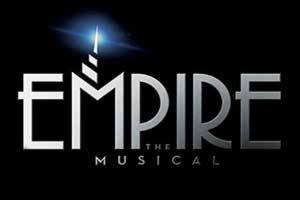Empire
A Broadway-bound musical about the Empire State Building launches at the La Mirada Theatre for the Performing Arts.

(© Michael Lamont)
The new musical Empire pays homage to the musicals of the '20s and '30s. The original score by Caroline Sherman and Robert Hull contains snappy songs and captures the bubbly effervescence of the classic age.
The show opens with New York Governor Al Smith (Michael McCormick), who hopes to erect the largest building in the world, the Empire State Building, to enhance his legacy. One hundred stories would leave a great impression. His righthand "man" Frankie Peterson (Stephanie Gibson) has bailed him out of many jams and Smith hopes she can pull off the impossible feat of completing his quarter-mile-tall monument to himself in 14 months. Frankie locks horns with the architect, Michael Shaw (Kevin Earley), which, in '20s musical terms translates into true love. As the skyscraper climbs, the media, the city government, and public protest create headaches for everyone. Then, tragedy strikes.
Sherman and Hull's score is a darling pastiche of songs like those written by Kern, Gershwin, and Porter in the era. The catchy "Heyday," a rollicking opening number, reflects the devil-may-care attitude of the upper crust moments before the stock market crash. The rousing "Empire" becomes a rally cry for progress. The score highlights the melting pot that is New York City by interpolating everything from Irish lilts for "Castles in the Air" to Native American chants for "A Change of Words" and "Touch the Sky."
The book's troubles begin with its tone. The breezy love story takes center stage, and it appears that Frankie's love life matters more to the writers than the setting of the Great Depression or the ramifications of launching such a vast project so quickly. Multiple characters are also inserted, such as a new father working on the scaffolding to make ends meet, the short newcomer who just wants to be respected, and the mysterious new worker, Bill Johnson, with a risky secret. The script sprinkles ominous foreshadowing to hint of dangers ahead, but the writers do not give the audience time to care about the characters, who fade into the background just as quickly as they arrived.
Though the central romance is carved out, the supporting characters act more as archetypes: Shaw, the Ayn Rand protagonist who sees his vision as tantamount; Frankie, the smartest person in every room but relegated to the background because of her gender; financier John J. Raskob (Tony Sheldon), who wants the glory, but not the responsibility. Unfortunately, time is not paid to the most interesting themes like the state of anxiety during the Great Depression and how the rich treat the workers like pawns for their own ambitions. Instead, Empire becomes Downton Abbey of the construction set, without time to delve into either side.
Gibson and Earley have strong chemistry as the lovers with a good sense of screwball-comedy rhythm. McCormick and Sheldon are appropriately oily as the politicians. Caleb Shaw and Katharine McDonough are touching as the Irish couple trying to bring a son into this tumultuous world. Tommy Bracco brings buoyancy to the small statured but charismatic Bucky. The dancers are all outstanding, perfectly coordinated and bring vitality during some particularly complex numbers.
The visual touches by director and choreographer Marcia Milgrom Dodge are remarkable. The dance moves are athletic and a delight to witness. She creates clever juxtapositions like a conga-dancing elite quickly covering themselves in rags and transforming into a breadline. At the end of a dance number for the construction men, they re-create the famous photo Lunch Atop a Skyscraper.
Leon Wiebers' costumes feature appropriate hand-me-down looks for the working class and dazzling, rich-looking dresses for the upper class. The impressive projection design by David Gallo and Brad Peterson, takes the audience to various locations like a 3D movie, with sectionals jutting out of the scenic wall to add depth. Unfortunately, the projections themselves were blurry.
Empire holds the foundation of a great musical play. Natural themes surrounding this landmark moment in history can excite audiences, while the score is already worthy of several listens. The book, though, requires further construction if it is to build a transfer to Broadway.









